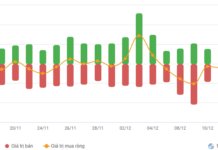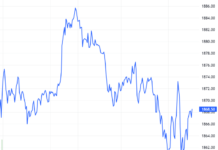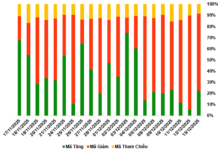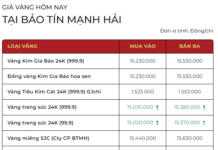
The Philippine economy witnessed a strong growth of 5.7% in Q1 2024, as per the latest data from the Philippine Statistics Authority. The government remains optimistic about the economic outlook, expecting a growth rate between 6-7% for the full year.
Philippines
According to the Philippine Statistics Authority, the economy grew by 5.7% in the first quarter of 2024, outpacing the 5.5% growth recorded in the previous quarter. The government remains optimistic about the economic outlook and expects a growth rate of between 6-7% for the full year.
Household spending, a key driver of the economy, recorded a solid 4.6% growth in Q1 2024. Exports of goods and services rebounded with a 7.5% increase, recovering from a 2.5% decline in the previous quarter.
Vietnam
Vietnam’s General Statistics Office reported positive economic and social developments in the first quarter of 2024, despite global economic uncertainties. The country’s gross domestic product (GDP) is estimated to have grown by 5.66% year-on-year, surpassing the growth rates of the first quarters of 2020-2023.
Agriculture, forestry, and fisheries contributed significantly to this growth, increasing by 2.98% and accounting for 6.09% of the total added value of the economy. The industry and construction sector grew by 6.28%, contributing 41.68%, while the services sector expanded by 6.12%, contributing 52.23%.
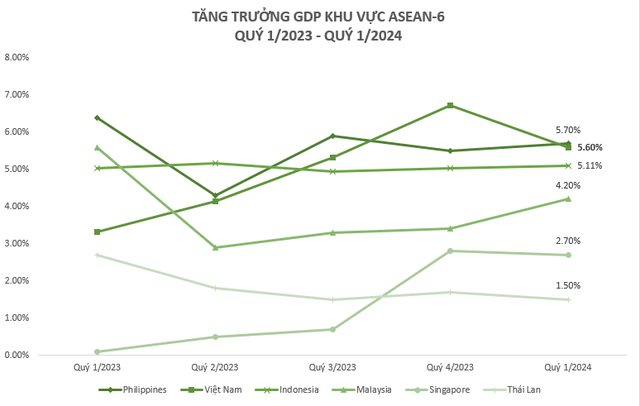
Indonesia’s economic growth was driven by a rebound in domestic economic activities, with key sectors such as mining, manufacturing, construction, and trade contributing significantly.
Indonesia
Indonesia, Southeast Asia’s largest economy, recorded a strong GDP growth of 5.11% year-on-year in Q1 2024, surpassing expectations. This growth was driven by a rebound in domestic economic activities, according to the Central Statistics Agency.
Despite a decline in the prices of key export commodities such as crude palm oil and coal in the first quarter of 2024, Indonesia’s economy expanded by 5.11%. This growth was supported by robust domestic economic activities, as stated by the Agency’s Acting Director, Amalia Widyasanti.
Manufacturing, mining, construction, and trade were the main contributors to this growth. Household spending also increased by 4.91% year-on-year in the first three months of 2024, up from 4.47% in Q4 2023, accounting for more than half of the country’s GDP.
Government spending witnessed a significant jump of nearly 20% in the first quarter, boosted by election-related funding. However, investment growth slowed to 3.79% in the first quarter of 2024, down from 5.02% in the previous quarter.
Malaysia
Earlier, the Central Bank of Malaysia announced that the country’s economy expanded by 4.2% year-on-year in Q1 2024, the highest growth rate in a year. This growth was driven by a recovery in export demand from foreign partners and robust private consumption. Compared to the previous quarter, Malaysia’s economy grew by 1.4% in the first quarter of 2024.
Private consumption increased by 4.7% in the first quarter, up from 4.2% in the previous quarter. Exports also rebounded with a 5.2% growth, reversing a 7.9% decline in Q4 2023.
The services sector, which accounts for a significant portion of the economy, grew by 4.7% in Q1 2024, an increase of 0.6 percentage points from the previous quarter’s growth of 4.1%. The manufacturing sector also showed signs of recovery, expanding by 1.9%.
Singapore
Singapore’s Ministry of Trade and Industry (MTI) reported a 2.7% year-on-year growth in the country’s GDP in Q1 2024, driven by a rebound in the tourism sector. The services sector, a key component of Singapore’s economy, expanded by 3.2% in the first quarter, up from 2% in Q4 2023.
Thailand
Thailand’s National Economic and Social Development Council (NESDC) recently announced the country’s economic growth for the first quarter of 2024. Thailand’s GDP grew by 1.5% year-on-year, largely driven by a recovery in the tourism sector, which accounts for nearly 20% of the country’s GDP.
Analysts attribute Thailand’s economic performance to two main factors. Firstly, high household debt has led to a decline in domestic consumption. Secondly, weak demand for goods in major markets such as China, the US, and Europe has negatively impacted the country’s exports.
However, tourism is playing a crucial role in Thailand’s economy. In the first quarter of the year, the country welcomed 12 million international tourists. The government has set a target of attracting 30-35 million tourists for the full year.
As of today, all six ASEAN-6 countries, including Thailand, Vietnam, Malaysia, Singapore, Indonesia, and the Philippines, have released their Q1 2024 GDP growth figures.
The Philippines leads the pack with a 5.7% economic growth rate in Q1 2024, followed by Vietnam at 5.66%. Indonesia comes in third with a 5.11% GDP growth, while Malaysia’s economy expanded by 4.2% during the same period. Singapore and Thailand recorded growth rates of 2.7% and 1.5%, respectively, rounding out the list.


